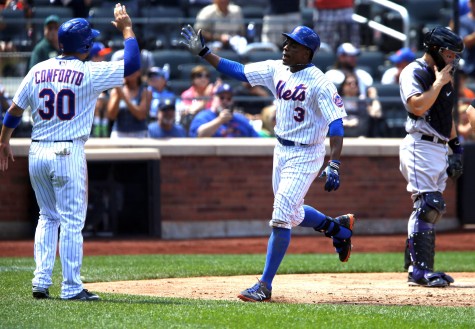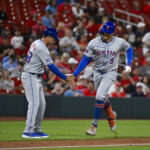
Curtis Granderson continues to rip the cover off the ball, blasting his 20th home run of the season in the fourth inning of Thursday’s 12-3 win over the Colorado Rockies.
The two-run shot matched Granderson’s home run total from last year and now gives him eighth seasons of 20 or more home runs in his career.
He remains red hot and has now reached base safely in 25 of his last 27 games dating back to July 12. He is hitting .287 (31-108) with seven doubles, seven home runs, 20 RBI and 20 runs scored during that span.
He has been the team’s most consistent and most valuable player on offense.
August 11
Don’t look now, but Curtis Granderson‘s “albatross” contract isn’t looking so bad after all.
Granderson certainly had a season to forget last year, batting .227/.326/.388 with 20 home runs in 654 plate appearances. Even worse, his defensive numbers were about as bad as they’ve ever been. Overall, his production amounted to a meager 1.2 fWAR, even worse than the year before, in which he only played 61 games.
Boy, how things have changed in a year’s time. With a productive weekend series, Granderson now owns a batting line of .259/.349/.454 line with 19 home runs. Notice the big increase in power. Granderson’s ISO has gone from .161 last season, the lowest of his career, to .195.
It took a while, but Granderson has finally become the big power threat that Sandy Alderson wanted when he signed him. What’s changed? It’s complicated, but basically, Granderson has been even more disciplined at the plate.
Ironically, Granderson’s strikeout rate is slightly up and his walk rate slightly down, but he is swinging at better pitches. His swing rate has dropped from 42.4 percent a year ago to 39.7 percent this year. The big change has been his swing rate on pitches outside of the strike zone, which has dropped from 26.2 percent to 21.5, his lowest since 2008. His swinging strike rate has dropped from 9.7 percent to 7.7 percent. Perhaps pitchers have taken notice of this, because he’s getting more pitches thrown to him in the zone, up five percentage points from last season. He’s seeing more pitches in the zone than he’s seen in any season since 2009.
The result? Granderson has been able to drive the ball much more effectively. Through 110 games, he’s already hit more line drives (83) than he did all of last season (80). His line drive percentage has risen from just 18.9 percent to 27.7 percent, a career-best by quite a lot. His hard hit ball rate has gone up significantly as well. I could go on, but I think it’s pretty clear now.
This all translates into a pretty massive rise in offensive production. With his bad defense in the outfield last year, Granderson’s 107 wRC+ was nowhere near what the Mets were hoping for. This year, it’s 127, second on the team only to Lucas Duda.
Granderson’s defensive metrics have improved dramatically as well, although I tend to take his with a grain of salt. Defensive Runs Saved has him 14 runs better than last year, while Fangraphs has him around 20 runs better.
Put it all together, and Granderson’s overall value is finally back where it needs to be. fWAR has him at 3.6 wins above replacement this season, while rWAR has him at 3.2 wins.
Either way, Granderson is finally living up to his contract, at least for now. Based on the amount of money per win above replacement teams are spending on the free agent market, Granderson has already been worth $28.5 million this season, and that will only surely go up.
Now, that doesn’t mean he would (or should) get that if he hit the market today (because he wouldn’t), but it goes to show you that maybe the Mets are getting their money’s worth.













